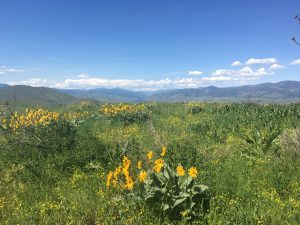Wet Bulb Globe Temperatures during the 2021 Heat Wave
As must be well known by all the readers of this newsletter, the Pacific Northwest suffered through a severe heat wave at the end of June 2021. In association with extreme geopotential heights aloft and thermally-induced low pressure near the surface, many all-time temperature records were set.
Read moreClimatology of WA’s Puget Sound Lowlands Climate Division (#3)
This is the third installment of the “Climate Divisions of WA” series, in which we discuss Climate Division 3 – the Puget Sound Lowlands Climate Division. For analyses of Climate Divisions 1 and 2, see the August 2018 and August 2019 editions of our newsletter.
Read moreThe Ideal Climate Index Results Are In!
Readers of this newsletter may recall the piece in the January 2021 edition featuring a link to a survey aimed at determining the location in Washington state with the best climate.
Read moreA Review of Winter 2020-21
As we head toward warmer temperatures, this is the time of year where we like to look back and review the WA state winter conditions. A moderate La Niña event developed early in fall of 2020, and the Climate Prediction Center (CPC) seasonal forecasts were calling for warmer and wetter than normal conditions for WA for the fall months.
Read morePNW 2020 Water Year Impacts Assessment Released
The Pacific Northwest Water Year 2020 Impacts Assessment has been released and is now available online. Sponsored by the NOAA National Integrated Drought Information System (NIDIS), OWSC and colleagues with the University of Washington Climate Impacts Group led this regional collaboration that involved researchers and state and federal practitioners from Idaho, Oregon, and Washington.
Read moreMountain Snow Depth gets a New Display
OWSC is pleased to release a new web tool that displays the bi-monthly snow depth data from the Northwest Avalanche Center (NWAC). Partially supported by Tableau, this was a collaboration between NWAC and OWSC and was recently featured in a UW News piece.
Read moreDoes the Arctic Oscillation Relate to the Variability in the Weather of WA?
The term “polar vortex” has been in the news recently, prompting this piece on the connection of the Arctic Oscillation (AO) to the weather of WA. In early January 2021, some attention was given to the polar vortex and the relationship to the sudden stratospheric warming that occurred near the pole (AO+).
Read moreWhat is the Ideal Climate?
The Camelot Climate Index (https://ggweather.com/ camelot.htm), created by Jan Null (Certified Consulting Meteorologist, Golden Gate Weather Services) to score U.S. locations based on an “ideal” climate, was recently discussed on the American Association of State Climatologists (AASC) listserv.
Read moreSurface Radiative Heat Fluxes
Meteorologists and climatologists go to considerable effort to figure out from where air masses originate, because of course that has a great deal to do with the weather. A good example pertains to the upcoming winter’s weather.
Read moreA Tale of Two Sea Surface Temperatures
There is a strong indication that at least moderate, and possibly strong, La Niña conditions will be present during the upcoming winter of 2020-21. Many readers of this newsletter know of the implications for WA state, namely improved odds of seasonal mean weather on the wet and cool side and healthy snow totals in the mountains at the end of winter.
Read more